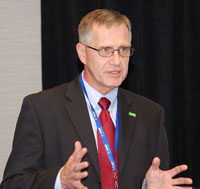The biggest news out of the recent BASF Agricultural Solutions Media Summit was the first Eco-Efficiency Analysis for corn in the Midwest, both with and without the fungicide Headline. The reason it was relevant is that it shows the potential for measuring sustainability.
 During a breakout session at the summit, BASF vice president for Crop Protection Marty Mascianica got into a bit more detail about the eco-efficiency analysis and how it was used to measure sustainability. “For us, sustainability is taking into account efficiency and cost-effectiveness for the farmer, as well as the most appropriate conservation of resources,” Marty told me. “The model that we used allows us to calculate a total cost of ownership – the financial cost of energy, water and other inputs, as well as the raw materials to make fertilizers and crop protection products – so that a farmer can understand whether his change in a practice is bringing about a greater cost of efficiency as well as the environmental impact.”
During a breakout session at the summit, BASF vice president for Crop Protection Marty Mascianica got into a bit more detail about the eco-efficiency analysis and how it was used to measure sustainability. “For us, sustainability is taking into account efficiency and cost-effectiveness for the farmer, as well as the most appropriate conservation of resources,” Marty told me. “The model that we used allows us to calculate a total cost of ownership – the financial cost of energy, water and other inputs, as well as the raw materials to make fertilizers and crop protection products – so that a farmer can understand whether his change in a practice is bringing about a greater cost of efficiency as well as the environmental impact.”
Marty says the data for the corn study are from research on corn production reported by Iowa State University which demonstrated a 7 percent average yield increase through the application of Headline, which resulted in both lower production costs and environmental impacts. The yield increase meant that farmers were able to harvest the same amount of corn using less land with fewer resources and lower energy consumption per unit of corn.
Listen to or download my interview with Marty in the player and find out more about the Eco-Efficiency model here.
